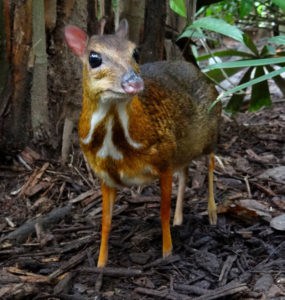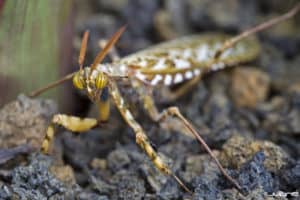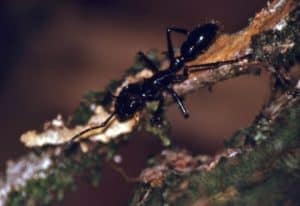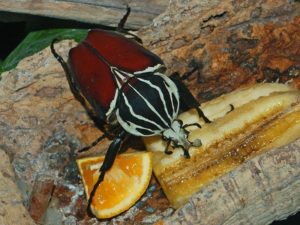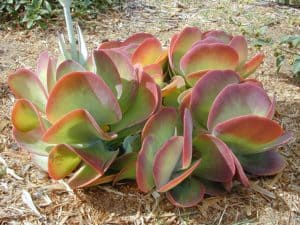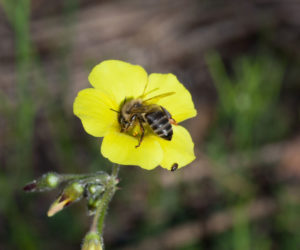Greater Malay Chevrotain Facts Related Articles Greater Malay Chevrotain Physical Description Despite its relatively tiny size, the Greater Malay Chevrotain holds some surprises in store for those who research it. That’s especially true of those new to knowledge of it. In fact, it actually constitutes one of the largest members of its genus. Further, the […]
Devil’s Flower Mantis
Source: http://bit.ly/2GEsEnx Photo: Juan Emilio CCL: http://bit.ly/2xLZ0ap Devils Flower Mantis Facts Related Articles Source: http://bit.ly/1mHidNM Photo: Sarefo CCL: https://bit.ly/3yqaEFs Devil’s Flower Mantis Physical Description Firstly, it should be noted that the magnificent Devils Flower Mantis, like many related species, displays sexual dimorphism. For example, the larger females can grow to about 5 in (13 cm) […]
Bullet Ant
Bullet Ant Facts Related Articles Bullet Ant Physical Description The powerful Bullet Ant ranks as a rather large variety of ant, like many of its related species. Workers also average around 0.7-1.3 in (18–30 mm) in length. In appearance, these comparatively small, yet extremely powerful, invertebrates strongly resemble reddish-black, wingless wasps, with its coloring. It also […]
Goliath Beetle
Goliath Beetle Facts Related Articles Goliath Beetle Physical Description Like most beetles, the Goliath Beetle possesses a reinforced first pair of wings. These serve as protective covers for its secondary pair of wings and abdomen. The second pair of wings is membranous and quite large. Only that pair remains useful for flying. When not […]
Pewits Nest
Pewits Nest Facts Related Articles Pewits Nest Physical Description First of all, the Nature Reserve containing Pewits Nest actually only covers a surprisingly small region. That holds true due to the fact that it encompasses a total area of only 9 acres (3.6 hectares). However, the site perfectly proves the old adage that beauty comes […]
Bat-Eared Fox
Bat Eared Fox Facts Related Articles Source: http://bit.ly/1jRBoV0 Photo: Yathin S. Krishnappa CCL: http://bit.ly/2IjEG4n Bat-Eared Fox Physical Description First of all, the fur of the fascinating Bat-Eared Fox has a decidedly eye-catching appeal. That’s because it predominantly appears brown and tawny in color, at least in the majority of individuals. Also, the rather distinctive markings […]
Kalanchoe
Source: http://bit.ly/2Sgnq3q Photo: Forest and Kim Starr CCL: http://bit.ly/2IwGIlo Kalanchoe Facts Related Articles Kalanchoe Physical Description Even though the various types of Kalanchoe all fall into the same classification, differences between them exist. That fact remains quite understandable, given the sheer number of member species. Most members of the fascinating group evolved as either perennial […]
Palawan Island
Palawan Island Facts Related Articles Palawan Island Geology, Geography, and Ecology This magical place in Asia has a total area of about 4,706 sq mi (12,189 sq km). The highest elevation on the jungle-covered island is 6,841 ft (2.085 m). The northern portion of this geological gem is famous for its crystal-clear waters, white sand […]
Deathstalker Scorpion
DeathStalker Scorpion Facts Related Articles Deathstalker Scorpion Physical Description The fascinating Deathstalker Scorpion exhibits sexual dimorphism. This occurs due to the fact the males of the species average about 3 in (7.5 cm) in length. The females, however, average about 4 in (10 cm) in length. Despite the difference in length, both genders average roughly 2.5 […]
Cape Honey Bee
Cape Honey Bee Facts Related Articles Cape Honey Bee Physical Description At first glance, the wonderful Cape Honey Bee bears a striking resemblance to another variety of honey bee sharing the same range. Like that species, and many others, it also displays the physiological trait of sexual dimorphism. However, this trait also displays itself in […]
